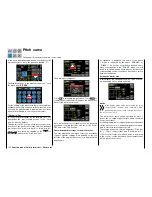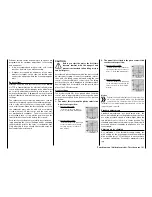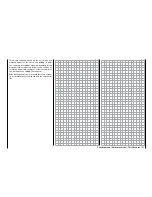
Different throttle curves depending on the phase are
programmed for optimum adjustment for hovering
and aerobatics:
• A lower system speed with smooth, soft control
reactions and less noise while hovering.
• A higher rotor speed for aerobatics at the maxi-
mum motor output. In this case, the throttle curve
needs to be adapted within the hovering range as
well.
Basic settings
Although the pitch and throttle curves in the
mz-24
HoTT Pro transmitter can be electronically adjusted
over a wide range, all the linkages in the model must
be correctly adjusted mechanically according to the
helicopter instructions. Experienced helicopter pilots
will in all likelihood be glad to help you with the basic
settings.
The carburettor control must be adjusted so that the
throttle is completely open at the maximum pitch po-
sition, or the motor control unit of an electric helicop-
ter is at full power. When the throttle limiter is closed,
the carburetor must also be able to be completely
closed with the CH1 trim control, and the servo may
not mechanically overtravel. The motor control unit
must reliably turn off the electric power when the
throttle limiter of an electric helicopter is closed.
Perform these settings very carefully by correspond-
ingly adapting the control linkage and/or changing
the articulation point on the servo or carburettor arm.
Only after this is done should the throttle servo be
finely adjusted electronically.
CAUTION
Before you start the motor the first time,
become familiar with the dangers and
precautions involved in handling motors
and helicopters.
After these basic settings are made, the motor should
be started according to the motor operating instruc-
tions, and the idling can be adjusted using the trim
control of the throttle/pitch control stick. The idling
position that you set is displayed in the transmitter's
basic display by a horizontal bar in the position dis-
play of the CH1 trim control.
Hover settings
The model should lift off the ground when the pitch
control stick is approximately in center position and
hover at the set speed. If this does not occur, proceed
as follows:
1. The model lifts off when the pitch control stick
is past center position:
a)
The speed is too low
Solution: Increase the value of
point "1" in the THR.CRV display.
a) The speed is too high
Solution: Increase the pitch angle
of the rotor blades by increasing
the value of point "1" in the PIT.
CRV display.
2. The model lifts off before the pitch control stick
reaches center position:
a) The speed is too high
Solution: Reduce the carburettor
opening by reducing the value of
point "1" in the THR.CRV display.
b) The speed is too low
Solution: Reduce the pitch angle
of the rotor blades by reducing the
value of point "1" in the PIT.CRV
display.
Notice
Perform these adjustments until the model hov-
ers at the right speed when the throttle/pitch
control stick is in center position. All the other ad-
justments of the model parameters depend on this be-
ing performed correctly.
Standard adjustments
Standard adjustments are performed after the
above-described basic settings where the model hov-
ers at the provided speed in normal flight when the
throttle/pitch control stick is in center position. The
standard adjustments are made to allow the model to
hover and perform roundtrips in all phases at a
con-
stant speed
.
Adjustments for climbing
A combination of the throttle/hovering setting, the
pitch setting for the hovering point and the maximum
pitch position (point "H") allows you to easily achieve
a constant speed from hovering to maximum climb-
ing.
163
Function menu | Helicopter model - Throttle curve
Summary of Contents for mz-24 PRO
Page 13: ...13 Personal notes...
Page 19: ...19 Personal notes...
Page 37: ...37 Personal notes...
Page 59: ...Touch 59 Base menu Model selection...
Page 79: ...79 Personal notes...
Page 89: ...89 Personal notes...
Page 115: ...115 Personal notes...
Page 153: ...Helicopter model function menus Common function menus 153 Personal notes...
Page 169: ...169 Personal notes...
Page 187: ...187 Personal notes...
Page 199: ...199 Personal notes...
Page 207: ...Fixed wing model function menus System menus 207 Personal notes...
Page 211: ...211 Personal notes...
Page 219: ...219 Personal notes...
Page 237: ...237 Personal notes...
Page 238: ...238 Personal notes...
Page 239: ...239 Personal notes...






























